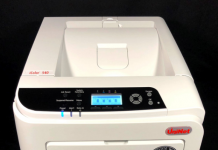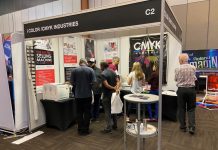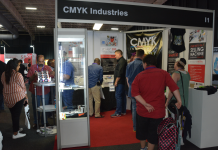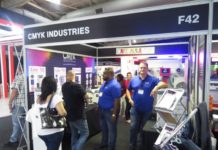Label printing has mainly been handled by conventional processes such as flexography, however, with run lengths becoming shorter and the demand for customisation, digital label printing is an attractive option that can complement conventional printing. Benefits of digital printing include getting jobs done faster, improving profitability and e fficiency and decreased material wastage and set up time for machinery. This article is taken from the Africa Print Journal.
Besides print houses who want to venture into digital printing, another target market who may benefit from doing labels in-house is big brands. Protecting the integrity of a brand is a major concern, and having a dedicated labelling division gives a business full control over colour management and production. It also cuts down on the time to proof the label as it eliminates the back and forth communication between the client and label printer and ensures deadlines are met. Markets include: beer, wine, beverage, food, coffee, cosmetics, chemicals, pharmaceuticals, private labels and more.
Shawn Bezuidenhout, Label Printing Systems (LPS), said Radio Frequency Identification technology, which is uniquely compatible with digital label production, gives businesses access to product information on an unprecedented scale. The technology can be used not only to track products – where they go, how they’re handled, who buys them and how they’re used – but also to help combat grey imports and counterfeiting by giving the manufacturer the freedom to adapt anti-counterfeiting measures on their labels at a moment’s notice.
'Another big advantage to in-house digital label production is how the technology lends itself to customised label shapes in the form of laser die cutters and digital blade cutters, enabling businesses to further differentiate their brands from competitors,' he added.
Of course, before a business explores digital printing as an option, they need to carefully consider the costs, and media is a large component. 'Importing media from overseas is not worth the investment as it's expensive and time-consuming,' said Patrick Naude, CMYK Industries. Users should also consider the differences between using inkjet technology versus a laser printer. 'Newer inkjet models are now faster and as cost effective as laser printers, but always check the prices of inks, heads and other supplies. Finally, consider the type of label sizes you need to print, as some labels may work out that they can only print onto A3 machinery, which is very costly versus the entry level A4 size engine,' he said.
Another factor to consider, according to Leon Minnie, Konica Minolta South Africa, is finishing, specifically the expenses associated with die cutting, rewinding labels, lamination, UV coating, spot UV and spot foiling. 'If the cost of finishing is too high, then perhaps you would need to keep printing in-house but out-source the finishing.'
A hidden expense that is overlooked is the minimum quantities of substrates required by the supplier to be purchased. 'If you want to try out a fancy material, for instance, you need to take into account the minimum order requirements, which could exceed the lifespan of the materials. For example, glue hardens so it doesn't apply after a certain time and you don't want to block up a store room with expired substrates,' added Minnie.
Some companies offer a comprehensive cost analysis to ensure businesses know what they're getting themselves into. Konica Minolta South Africa for instance does a cost analysis using business tools to verify cost per label, percentage of the machine used, monthly production capacity and benchmarking against other label print process like flexo, among other aspects, to ascertain if digital printing is the right fit for your business.
Below, label printing suppliers offer advice on bringing label printing in-house.
Arctec
Which products do you offer that would be ideal for bringing labels in-house?
Trojan3
This overprinting system can be mounted in any host system which runs at speeds of up to 18 metres per minute, enabling high quality 4-colour printing on all materials with an absorbable surface such as most kinds of uncoated papers and cardboards or materials that are pre-treated for aqueous inkjet printing. The flexibility of the overprinting system means that it can be used to print on flat objects such as unfolded boxes or labels, thick objects like blister envelopes and wooden planks or even folded boxes ready for shipment.
Scorpio SCR22PL
Built to meet the demand of short run label finishing, the Scorpio SCR22PL is the ideal companion for inkjet and digital label printing. Full user flexibility allows for the limitless label designs and shapes without the need for expensive dies. It allows users to produce professional grade, full bleed labels on demand with versatility and precision. The Scorpio software works together with a camera, forming an integrated optical black-mark registration system. The camera detects the black mark printed on the media and the software matches it to the cut file created using CorelDRAW or Adobe Illustrator.
TrojanTwo
This affordable mini digital press has the characteristics of the larger and more expensive systems. The press runs at 18m/min and up to 1600 x 1600 dpi. With sophisticated algorithms and a self-maintaining system, it can run larger volumes and maintain high print quality.
———————————–
CMYK Industries
What are the benefits of bringing label printing in-house?
Convenience: you can print from two to thousands of labels, so as you get a job, you merely print it, there is no more stocking up on labels in the store room.
What do users need to keep in mind to ensure they're making a profit or breaking even?
The beauty of digital machines is there is no real minimum runs, like you find with flexo printing. Remember that flexo serves a purpose and there will always be a breaking point where flexo becomes cheaper. Generally, your minimum run should be as much as you need to make a profit. It will depend on the size of the label too. Remember, if your label size is bigger than A4, you will need a bigger A3 print engine.
Complying with material regulations
If materials are being used for food or cosmetics, then labels and materials need to comply with regulations. In the chemical industry, you will need to have an accreditation on your machine and media. There are substrates suitable for packaging, such as 'dairy film', which can be frozen and put into fridges. A point to remember is that your label must be legible once it has got wet and been applied in its various places. So be careful when you purchase your machine and make sure it is suitable for your applications. The more complex jobs or applications you require, the more costly the media is.
Which features should one look for in a label machine?
Speed, running costs, width of media it can handle, monthly pages it can print, is it user
friendly, easy to change the supplies like inks, toners, drums, belts, paper or paper rolls etc.
Which products do you offer that would be ideal for bringing labels in-house?
We offer three machines in the desktop sheet feed category: namely H20, iColor 500 and iColor 600 machines. All of these print CMYK and White in a single pass and come with RIP software, having a costing facility in them, and are easy to operate. These machines depend on the user and their budget.
For the production type companies and resellers of labels, we have the iColor 700 and iColor 900. Both systems are full colour digital with fluorescent white print capabilities. The i700 is A4 width and the i900 is A3 width. They both have a RIP software and costing facility on them, they can handle variable data as an option too.
All our systems are LED laser based and print on a variety of media like Matte, semi gloss, cast gloss, clear gloss (water bottle labels), PET, PP, GHS certified media (chemical and maritime industry) foils etc. to name a few. Our machines have the lowest fusing temperature on the market, allowing them to print on all the above variety of media.
————————————–
Graphix Supply World
Which products do you offer that would be ideal for bringing labels in-house?
Primera LX500e
Fast print speeds and an optional built-in guillotine-style cutter allow users to quickly and easily print and cut their short-run labels. The LX400e is up to 270% faster on labels printed with comparable print quality. Typical applications include product labels for coffee, wine, bakery, confectionary, meat, cheese and hundreds of other specialty and gourmet foods. The LX500e also accepts tag stock that can be cut with the optional built-in cutter, making it ideal for producing visitor, convention and meeting badges.
Primera FX400e Foil Imprinting System
The FX400e adds brilliant, shiny metallic gold and silver highlights to inkjet-printed labels. The system is an optional accessory to any of Primera's LX-Series colour label printers. The process is 100% digital, so you can print virtually any design: borders, graphics, fonts, backgrounds and more. TuffCoat certified foil in Gold and Silver is available for the FX400e, as well as Clear, White and various spot colours. It lets you produce labels with a high degree of resistance to water, chemicals, cleaning solutions, UV and other harsh environmental factors.
Primera CX1200
Colours are bright and vibrant, text is sharp, and bar codes and graphics are of the highest quality. From pressure-sensitive papers to white and clear polyesters and more, CX1200 gives maximum substrate flexibility. A wide range of approved matte, semi-gloss and high-gloss materials are available, allowing for precisely matched substrates to specific customer requirements.
Primera LX900e
The LX900e’s specially-designed pigment inks, when paired with Primera’s Tuffcoat Extreme Polyjet material, offer far more stability against harsh conditions, including water, chemicals, abrasion and exposure to long periods of UV light. A significant advantage of the LX900e’s implementation of pigment inks is that the printer can use either pigment or dye-based inks by simply changing out the removable print head.
Primera LX2000
The LX-series colour label printers provide short-run colour label printing and use the latest in high resolution inkjet technology to print brilliant, colourful labels for products. The series will save time and money by bringing your label production in-house. Printed labels can include photos, graphics, illustrations and text, even high-resolution linear or two-dimensional bar codes.
Mimaki Print & Cut CJV150-75
This is suitable for simple stickers and labels. The continuous register mark detection function enables the continuous cutting of a whole roll of media while simultaneously taking up unrolled media. Over-cut and corner-cut functions ensure clearly cut edges with no residues and the segment correction function facilitates precision cutting over longer-length prints. The cut-and-print function averts printing problems by cutting the media prior to printing.
NEW SOLUTION
• NS PRO: for the serious label printer with multi-job, continuous printing.
• NS MULTI: Powered by Memjet, it allows users to install variable data software and alternative RIP solutions as business needs develop and grow.
• NS F22: an all-in-one finishing solution, it has been completely re-imagined with a digital cutting plotter, cold lamination point, die cutter and slitter.
• NS ATOM: the perfect desktop solution for printing onto pre-cut labels.
———————————
Kemtek Print Solutions
Which products do you offer that would be ideal for bringing labels in-house?
HP Indigo 8000 digital press
At a speed of up to 79.9m (262 feet) a minute, digital benefits meet mainstream productivity for the production of any job. Advanced colour automation and sophisticated colour matching tools make it fast and easy to hit brand colours with extreme accuracy, consistency and repeatability. Users can produce a wide range of narrow-web applications with easy and quick changeovers, including pressure-sensitive labels and shrink sleeves. Print on substrates from 0.5 pt to 18 pt, including off-the shelf substrates with in-line priming. HP Indigo ElectroInk Premium White delivers high opacity white in a one-pass process, opening new digital opportunities.
HP Indigo WS6800 digital press
This is a productive, flexible and high-quality printing solution for the label and packaging converter. The press has a record-breaking printing speed of 40 metres per minute, and a maximum speed of 60 metres per minute in a 1- or 2- colour mode. It enables automated and efficient production of labels, flexible packaging, sleeves, and folding cartons. The WS6800 streamlines these applications by automating press processes and integrating inline optional components for priming and finishing, supporting the widest media gamut available for digital production.
——————————-
Konica Minolta South Africa
What important cost considerations should businesses keep in mind?
Although digital printers are easier to run than flexo, you still need qualified staff who know how to plan print, manipulate colours, and handle any post-finishing. We offer two training sessions, one basic, and one advanced, to our clients. You'll also need a dedicated space for media and printing, which should be downstairs so media can be easily brought through and equipment can be delivered and installed.
Businesses need to be knowledgeable about different types of media, and ensure they're suitable for the required applications. For example, certain glues won't work on a water bottle or products going into a freezer.
The volume has to justify a return on investment. However, one must consider the flexibility gained from digital printing. Being able to use labels in a marketing capacity, where companies can do versioning of different brands, or short and specific marketing campaigns with variable data printing, like the famous Coca-Cola example of personalised cans, is a major benefit. Providing premium products that are tailored to specific market segments can offset the volume cost.
How can users make their labels stand out from the competition?
Big brands can do versioning of their different brands and variable data printing, which allows for creativity – a key aspect of making a product attractive because it's different and creates interest. Effects such as spot foiling, raised surfaces and textures, holographic labels and special laminates go beyond the visual sense and engage a consumer's sense of touch as well.
Which products do you offer that would be ideal for bringing labels in-house?
The bizhub PRESS C71cf digital label printer is a complete label solution that is ideal for those looking to shift volumes from conventional presses to digital, in order to deal with shorter print run lengths, requests for faster delivery times, personalisation and versioning, and the production of on-demand runs. The press offers outstanding productivity, brilliant image quality and a surprising ease of use. The innovative label printer is ideal to expand into new markets and perfectly complements existing analogue machines. The C71cf is verified as environmentally friendly and food safe, with certifications stating that the label is safe for consumption and doesn’t harm the environment, with 100% biodegradable toner.
——————————-
Label Printing Systems
One of the primary factors driving the growth of the label production industry is the constant stream of regulatory requirements mandating changes on a variety of product labels, and this shows no signs of abating. Another major factor driving the growth of digital label production is the trend to connect packaging to social media and digital branding campaigns.
This especially impacts label production because of the relative ease of label application versus other packaging and especially the prevalence of digital label production systems. Bringing label manufacture in-house enables businesses to control the label making schedule, quantities, colour management, immediate availability and make changes as marketing and legislation requires in a very short turnaround time. In addition, they can produce labels on-demand, virtually eliminating waste. The immediacy of the technology enables companies to respond to market changes and competitor opportunities.
A 2012 PRIMIR Study, with research by Karstedt Partners stated: 'In the 2010 PRIMIR study, 'Benchmarking and World Market Trends for Flexographic Printing', 73% of label run lengths were less than 10,000 metres with 25% of the total under 3,000 metres. Additional information on run length trends can be found in a 2011 study published by Karstedt Partners addressing digital printing’s viability in the labels segment.
The Karstedt study shows that in North American label production, 57% of label jobs are for orders of less than 50,000 labels. Looking further, all orders of less than 50,000 labels accounted for 623,932,154 MSI (Thousand Square Inches) of the total 13,583,867,623 MSI of finished printed labels or only 4.5% of the label volume.
Put simply, 57% of orders represent only 4.5% of volume. This speaks volumes to the application’s need for operational flexibility and illustrates why digital printing systems are successful in penetrating this market and why eight out of ten of our label converters interviewees say they will get into or expand their capabilities in digital printing over the next five years.' Interesting information to come out of this report is that label converter interviewees identify food and pharmaceutical verticals with the greatest volume focus. They see medical, health and beauty and nutraceuticals with the greatest value focus, while beverages, industrial and household products are mixed. This is interesting in light of the brand owners interviewed where the beverage and pharmaceutical interviewees both ranked labels with the highest value of all the packaging applications.
It’s important to note that although the in-house label production market is growing at a steady rate of just over four percent annually worldwide, in-house labelling is unlikely to put label converters out of business. However, the report does highlight that unless label converters are catering to this market and servicing the consumer demand for digital in addition to their traditional markets, they are looking at losing a lot of market share to suppliers who adapt their business model to accommodate world market trends.
Which features should one look for in a label machine?
This depends on your requirements. The most important thing is to find a machine supplier who has a keen understanding of the market both locally and abroad and a supplier who will listen to your needs and offer a solution that’s a perfect fit. The supplier you choose should have technical staff on hand locally, qualified to service your label printer and assist with design and optimisation. In short, what you need is a supplier who has a vested interest in the success of your project and will be with you every step of the way as needed.
Which products do you offer that would be ideal for bringing labels in-house?
LPS is well established in the market and the only authorised Epson Colorworks reseller partner in Africa. They offer a broad range of labelling solutions to suite every requirement from entry level to advanced high production digital labelling systems from 10.7cm to 33cm (4” to 13”) label printing widths.
The Epson TM-C3500 for example is an excellent roll-fed starter label printer and comes bundled with label design software and prints on pre-cut labels, eliminating the need for additional finishing systems. There’s a wide variety of media available for it and the dye-based pigments are water resistant, chemical resistant, and scratch resistant provided the right media is used. In addition, bulk winder and rewinding systems are available as add-ons should production capacity need to be increased.
Higher volume machines in the range are the Epson TM-C7500 and TMC7500G. These feature bigger ink tanks to further lower production costs and incorporate single pass technology to speed the printing process. This machine is designed to seamlessly complement the widely used Zebra Line Printers, adding full colour options to the existing capabilities of these commonly used machines.
The very top of the range features the Anytron roll-to-roll high-volume label production system with separate finishing options available such as laser, blade and semi-rotary die-cutting, lamination, waste removal and roll conversion.





















